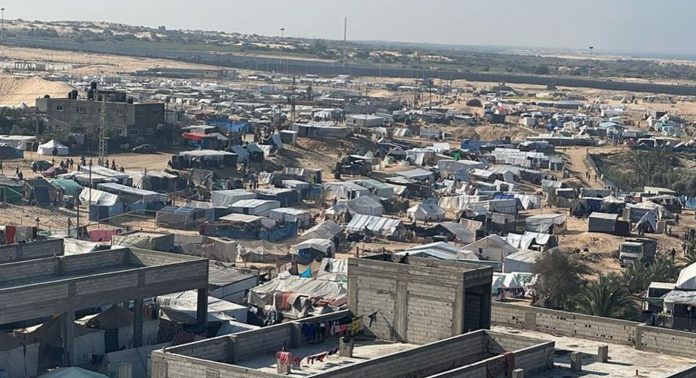As the new year began, Israeli air attacks continued to batter Gaza, destroying towns and refugee camps that Prime Minister Benjamin Netanyahu claimed would take “many more months” to end.
Netanyahu’s threat to reestablish Israeli sovereignty over the enclave’s border with Egypt raises new questions about a two-state solution, while his statements imply no let-up in a campaign that has killed thousands and leveled most of Gaza.
On Sunday, the Israeli military announced it would discharge some reservists called up to fight Hamas in Gaza to boost the economy as it prepares for a long conflict.
Air strikes on al-Maghazi and al-Bureij in central Gaza killed 10 people in one house and drove many to run to Rafah on the Egyptian border from the front lines where Israeli tanks are fighting Hamas fighters.
Central and southern Israel heard alarms overnight as Gazan rockets rushed toward it. The Israeli media showed many interceptions. Direct hits were unreported. Hamas’ armed wing blamed “massacres against civilians” in Gaza for the barrage.
A Sunday Red Crescent video showed rescuers carrying an injured child from smoldering rubble in downtown Gaza in the dark. Medical officials reported six deaths in an attack on the al-Mughraqa community outside Gaza City. A separate Khan Younis house strike killed one and wounded others, they said.
As 2023 ended, Gazans prayed for a ceasefire but had little optimism for the new year.
“Firecrackers will light up the sky in many countries tonight, and laughter will fill the air. Israeli missiles and tank shells are falling on innocent, destitute citizens in Gaza, said Zainab Khalil, 57, a northern Gazan now in Rafah.
The Israeli military’s proclaimed purpose is to eradicate Hamas, the Palestinian resistance group that launched a surprise cross-border attack on Israeli cities on October 7, 2023, killing 1,139 settlers and taking 240 captives.
Israel’s air and artillery assault has killed around 21,800 Gazans, with thousands more thought dead in the wreckage, and forced virtually all of its 2.3 million citizens to flee. According to the Palestinian health ministry, 70% of Gaza’s deaths are women and children.
Israel blocked most food, fuel, and medical supplies after the October 7 strike. On Sunday, it said it would let Western ships transport aid directly to Gaza after security checks in Cyprus.
OCHA representative Gemma Connell said many of the tens of thousands fleeing to Rafah had no possessions or a place to sleep.
“I just am so fearful that the number of deaths that we’ve been seeing is going to increase exponentially, both because of this renewed offensive and also because of these conditions, which are literally unbelievable,” she said.
“Where will people go?”
Israeli allies, including the US, have urged the war to end, and European nations have expressed concern about Palestinian civilian suffering.
On Saturday, Netanyahu declared he would not resign despite opinion surveys showing his administration is unpopular and defended his security record despite the October 7 incident, indicating that there will be no softening soon.
Netanyahu declared that “the war is at its height” and that Israel must reclaim Gaza’s border with Egypt, which is now full of civilians fleeing the horror.
Retaking the border would also reverse Israel’s 2005 pullout from Gaza, raising doubts about the enclave’s future and a Palestinian state.
Israel’s Iron Dome intercepts Gaza missiles. Photo: Reuters
Israel’s Iron Dome intercepts Gaza missiles. Photo: Reuters
Washington advised Israel to let a Palestinian government run Gaza after the war.
“We just take a fundamentally different view here in terms of what post-conflict Gaza needs to look like,” John Kirby told ABC.
Sunday’s appeal by Israel’s hard-right Finance Minister Bezalel Smotrich for Palestinians to leave Gaza and make room for Israelis who could “make the desert bloom.” raised questions about the offensive’s goals.
That contradicted the Israeli government’s statement that Gazans can return home. While barred from the core war cabinet, Smotrich and other hardline coalition ministers have sought to participate in conflict decisions.
In his final remarks as Israeli foreign minister before taking over the energy ministry on Sunday, Eli Cohen suggested Hamas’ recent weapons came from the border.
Senior Palestinian Authority official Hussein al-Sheikh in the Israeli-occupied West Bank claimed on social media that Israel taking over the border showed a decision “to completely return the occupation.”
We relocated from Khan Younis to Rafah because it was safe. Umme Mohammed, 45, a Palestinian woman sheltering at the border, said Rafah is full.
“If they control the border, where will people go?” she wondered, exclaiming, “a disaster.”
Maersk cargo ship hit
The confrontation might escalate to include Hamas ally Iran and other Middle Eastern factions.
Israel said it hit targets in Lebanon on Sunday after continuous cross-border fire with Hezbollah. Hezbollah assaults bordering Israeli sites and army groups. The opposition organization has degraded Israel’s border monitoring and caused substantial casualties with a variety of weapons.
Israel has struck Syrian resistance groups, while Iraqi groups have attacked US sites.
The US military said Yemen’s Iran-aligned Houthi militia attacked a Maersk cargo ship in the Red Sea for weeks in reaction to Israel’s battle in Gaza.
The military said US naval helicopters sank three of the Houthis’ four small boats used in Sunday’s attack and forced the fourth back to shore.
Israel says 174 soldiers have died in Gaza, but its operations are progressing, including demolishing Hamas tunnels.
Hamas and Islamic Jihad, which aim to abolish Israel’s settler colonialism, continue to target Israeli forces in the enclave.
